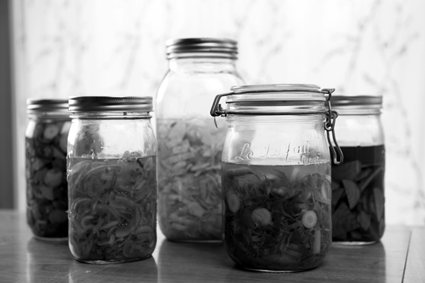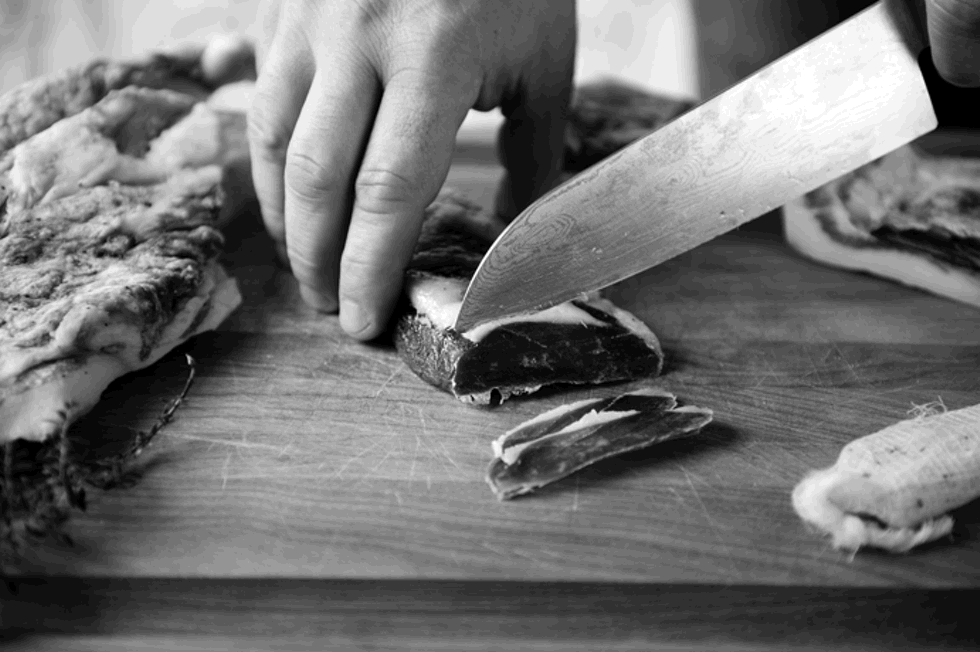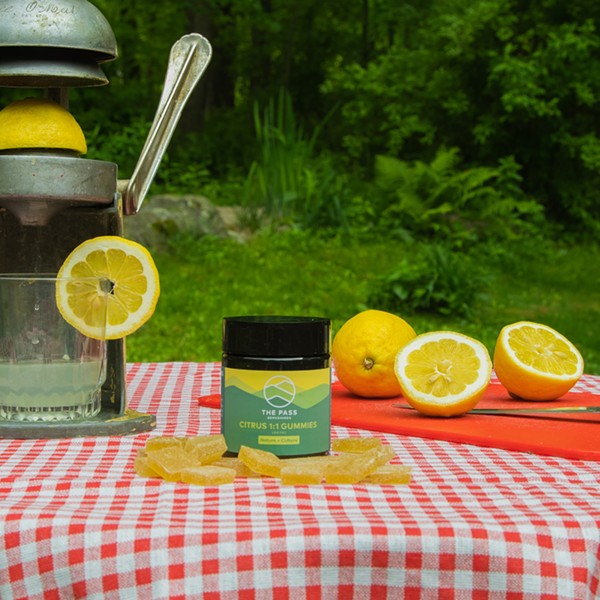Salt is the only rock that we eat. It’s essential for our survival, was used as currency, and is now available in a dizzying variety of textures and varieties from all corners of the world. It is also the key to transforming humble meat and vegetables into sublime delicacies that can completely change our relationship with everyday ingredients, giving us more control over our diets and allowing us to add an artisanal flourish to our cooking. As Mark Kurlansky notes in Salt: A World History (Penguin, 2003), “Salt is so common, so easy to obtain, and so inexpensive that we have forgotten that from the beginning of civilization until about 100 years ago, salt was one of the most sought-after commodities in human history. Salt preserves. Until modern times it provided the principal way to preserve food.”
The careful combination of salt and time results in staples which kept our ancestors alive through many thousands of winters, and happen to also be profoundly tasty—they add extra bass and treble, as it were, to our home systems. And making these wonderful foods in your own kitchen couldn’t be easier (or cheaper).
Picture a fast-food breakfast muffin: a warm, damp, greasy little stack of culinary defeat. All the ingredients are industrially produced, and it’s laden with fat and cholesterol. It’s not good for us, or for the planet. But it’s convenient, and ostensibly inexpensive. Now picture a similar arrangement, but with crisp slices of home-cured pork, a local egg, and your own crunchy kimchi on good toast: a toe-curlingly satisfying (and guilt-free) experience. With little more than a bag of salt and a few minutes on a weekend, you can make this your new standard for breakfast and never look back.
Salt preserves food in two main ways: dehydration and fermentation. Dehydration, or curing, is usually used for meat and fish. A filet of fresh wild salmon, covered in salt, brown sugar, and some flavoring (fennel seeds, citrus zest, a little hot pepper) for a couple of days, becomes lox. Fermentation takes place in a brine, where benevolent microbes create acid and thus create pickles. Shredded cabbage and salt, packed together in a ceramic crock and left somewhere cool, will produce tangy, funky, authentic sauerkraut in a week or two.
Our bodies need salt to live; without it we cannot regulate the flow of water between our cells, tissues, and organs. Different levels of salinity in our bodies cause water and salt to migrate back and forth across our cells’ semipermeable membranes in order to reach a balance. This process, known as osmosis, is the key to how salt has been used for countless millennia to preserve meat and fish. If a cell—either of muscle tissue or an undesirable bacterium—is exposed to enough salt, the osmotic pressure from the salt will pull the water from the cell, drying it out. This kills the bacterium and makes the meat an inhospitable environment for future microbial growth.
Sugar is often included in a cure, as a balance against excessive saltiness, and because it creates even more osmotic pressure than salt. If the cure in question has also been mixed with herbs and garlic, then those flavors will migrate into the meat along with the salt. After about a week packed in salt, sugar, garlic, and herbs, a pig jowl or belly will weigh significantly less than its starting weight; the formerly dry cure will now be a liquid brine from all the water the meat has given off. The denser, salty, richly flavored meat is then ready to be air-dried or smoked.
Whether you want to preserve meat or vegetables—or both—the quality of the ingredients you use will determine the quality of the finished product. This begins with the salt. Unrefined sea salt, though a little more expensive than standard table salt, contains important trace minerals and has a gentler flavor. Kosher salt is an acceptable substitute.
In the case of meat, local, organic, humanely raised animals will give you results of astonishing flavor and quality. Factory-raised meat will not. A hog jowl, after a week on a cure and a month hanging in a cool place, yields guanciale: an Italian delicacy and essential for making pasta all’amatriciana. The same treatment given to pure strips of fatback yields lardo, eaten in thin slices as an antipasto or as an addition to soups and sauces. A duck breast subjected to a similar treatment makes an astonishing “prosciutto” while involving a tiny fraction of the time, effort, and space required to make the real thing. Your friends will also think that you’re a genius, although having them drop by all the time for snacks may not be. Charcuterie by Michael Ruhlman and Brian Polcyn (W. W. Norton, 2005) is an excellent guide to making these and many other delicacies.

Local, seasonal, organic vegetables taste better, and result in vastly superior food; if you pickle California cucumbers in January you may wonder what the fuss is all about, but if you grow your own (along with some garlic and dill) and brine them within hours of picking, you’ll never want to buy another pickle again.
In winter, kale, cabbage, and roots are all at their sweet peak and make superlative pickles that beautifully accompany the richer food we eat to keep warm. By submerging vegetables in brine, we can kill or inhibit many of the bacteria and spores that would cause them to spoil. In addition, the saline environment encourages the growth of lactobacilli, a family of bacteria used for making a wide variety of fermented foods, from cheese and yogurt to beer and kimchi. These bacteria convert sugars from the food into lactic acid, which gives the sour, pickled flavor and prevents the growth of undesirable organisms.
For kimchi, sauerkraut, and vegetable pickles, a ceramic crock specially designed for the job will give the best results, but a large mason jar will also do fine. The principal difference is that the crock has weights to hold the vegetables under the surface of the brine—which prevents undesirable mold from forming—and has a special lid which holds a small amount of water to allow gases to escape during fermentation without allowing any contaminants in. A sterilized rock or zip-top plastic bag filled with water can serve as a weight if you’re going to use a glass jar, though you’ll need to leave the lid open a crack to let the gases escape. The only other piece of equipment you need is a simple digital kitchen scale that measures metric units. A normal brine concentration is in the four-to-five-percent salt range, and that is most easily achieved by dissolving forty to fifty grams of salt per liter of water (a liter of water weighs one kilogram; the metric system is way easier for this).
There are as many recipes for kimchi as there are Korean grandmothers, but a mix of napa cabbage, carrot, and scallion with garlic, ginger, and hot red pepper makes possibly the single most addictive raw vegetable food in the world. The considerable pleasure to be had from eating it right out of the jar is equaled only by the satisfaction of having made it yourself. Change the mixture of vegetables, and you’ve got giardiniera for salads or pasta. A head or two of cabbage shredded and fermented either by itself or flavored with black pepper, caraway, and juniper berries makes a superlative sauerkraut for reubens (tempeh or pastrami) and grilled sausages of any kind.
These various foods, besides helping you develop a deeper relationship with your food, also bestow many benefits. The live cultures, vitamins, and fiber in raw fermented pickles are extremely beneficial to our bodies; they aid digestion, boost the immune system, and may even help prevent cancer. There’s a wealth of information available about the health benefits of fermented food. Sandor Katz, author of the cookbook cum polemic Wild Fermentation: The Flavor, Nutrition, and Craft of Live-Culture Foods (Chelsea Green, 2003), sums it up simply “The data adds up to this: Fermentation makes food more nutritious.” Pickles are also a perfect companion to almost every savory dish—from a vegan lentil soup to a hunk of seared steak, they make everything taste better, exciting our palates.
Related
Having a couple of cured meats in the pantry means that we can use a few slices of guanciale or lardo to impart a deep, porky richness to a soup or a pot of beans without the calories or expense of putting a whole chop on the plate next to it. And if you have a smoker, homemade bacon is a life-changing experience. (If you don’t, you can still make pancetta, which is almost as good.)
As with canning, there are some safety concerns when salting food, especially meat. Most books call for using nitrite when curing meat to guard against botulism. It’s not always necessary, but thorough research is required. There are plenty of good books available with detailed procedures and recipes, and complete information about the conditions (anaerobic, protein-rich, nonacidic) in which harmful organisms can grow. Keeping ingredients, tools, and surfaces clean is always essential. Don’t let any of this dissuade you—the payoffs are huge, and wide-ranging; from a health, economic, and taste perspective, these simple, ancient techniques will elevate your experience as both a producer and consumer of food.


















